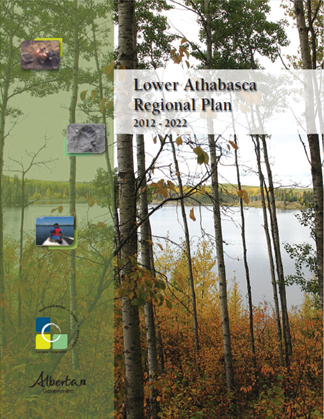Alberta Environment and Parks (AEP) Regional Plans
Lower Athabasca Regional Plan
Lower Athabasca Region covers an area from the south edge of the M.D. of Bonnyville to Alberta's northern border and includes Fort McMurray, Cold Lake and Lac La Biche. It has experienced rapid development, particularly during the past decade. The Lower Athabasca Region comprises a large section of northeastern Alberta, covering about 9,321,180 hectares.
Resources and Links
The Regional Plan Status: Regional Plan Approved |
|
|
|
The Lower Athabasca Regional Plan: 2012-2022 (2012) was approved on August 22, 2012. It became effective on September 1, 2012. An updated Lower Athabasca Regional Plan Draft (2011) advances a new approach for managing our lands and natural resources to achieve our province’s long-term environmental, economic and social goals. Feedback is used to produce the final plan (August 2011) The Lower Athabasca Regional Plan: Draft (2011): a blueprint to manage economic development, support vibrant communities and maintain a healthy environment (April 2011) Proposed Lower Athabasca Integrated Regional Plan Regulations (2011) which enables achieving the strategic direction, strategies and actions. |
The Land-Use Secretariat |
|
Alberta Land Stewardship Act (2009) The legal basis for the development of regional plans under the Land-use Framework. In 2011, amendments to ALSA provided greater clarity. Alberta Land Stewardship Regulation Provides clear rules for Albertans concerning the implementation of regional plans under the Land-use Framework. Provides a blueprint for land-use management and decision-making that addresses Alberta’s growth pressures. Land-use Framework: Understanding Land-use in Alberta (2007) The way in which land is used, the land-use issues, and the choices required to best manage and sustain land for Alberta's future. |
|
LUS Supporting Documents |
|
|
|
Progress Reports Land-use Framework Regional Plans Progress Report: A Review of Our Progress in 2014 The second progress report for LARP identifies most of the 35 strategies (found in Table 2 of the plan) are on track or ongoing however 6 initiatives are delayed. Land-use Framework Regional Plans Progress Report: A Review of Our Progress in 2013 The first progress report for LARP identifies most of the 35 strategies (found in Table 2 of the plan) are on track or ongoing however 5 initiatives are delayed. |
|
Phase 3 |
Feedback on the Government of Alberta's draft regional plan for Lower Athabasca Region (completed November - February, 2014) Phase 3 Public Consultation Summary: Draft Lower Athabasca Regional Plan (2014) Phase 3 Stakeholder Consultation Summary: Lower Athabasca Regional Plan (2014) Phase 3 Public Workbook Summary: Lower Athabasca Regional Plan (2014) |
|
Phase 2 |
Feedback on the advice from the Lower Athabasca Regional Advisory Council (completed: November - December 2012) Phase 2 Public Consultation Summary: Lower Athabasca Regional Plan (2013) Phase 2 Stakeholder Consultation Summary: Lower Athabasca Regional Plan (2013) Phase 2 Public Workbook Summary: Lower Athabasca Regional Plan (2013) |
|
The Lower Athabasca Regional Advisory Council’s Advice to the Government of Alberta Regarding a Vision for the Lower Athabasca Region (2010) describes the RAC’s advice to the Government of Alberta as a response to the Terms of Reference developed for the region. Its contents inform the second phase of public, stakeholder and aboriginal consultation and the development of the draft regional plan. |
|
|
Phase 1 |
Public information and input sessions on the Lower Athabasca region and awareness (completed: May - June 2009) Phase 1 Summary of the 2009 Phase 1 Consultations: Lower Athabasca Regional Plan (2010) |
|
Meeting Agendas and Notes |
Lower Athabasca Regional Advisory Council Agendas and Notes (June 2009 to November 2010) Scroll down to bottom of page to find links for the meeting agendas and notes from this RAC. |
|
Regional Advisory Council |
Lower Athabasca Regional Advisory Council Members (2009) Cabinet appointed the Lower Athabasca Regional Advisory Council members in December 2008 to provide advice, insight and perspective on current and future land-use activities and challenges in the region. The RAC is comprised of members with a cross-section of expertise and experience in the region. |
|
|
Lower Athabasca Regional Plan: Profile of the Lower Athabasca Region The profile provides an overview of key social, economic and environmental factors in the region that need to be considered in developing a regional plan. The report outlines major land uses currently underway, highlights important trends and identifies additional or changing human activities that can be expected in the region. |
|
|
Terms of Reference for Developing the Lower Athabasca Region (2009) sets out the process by which the regional plan will be developed, and provides guidance from Cabinet on specific economic, environmental and social factors that must be considered in the region. |
Videos |
|
Video: |
|
Other Publications |
|
|
|
|
Documents Referenced in the Lower Athabasca Regional Plan (xxxx) |
|
The plan references other associated plans, policies, groups and documents that support the LARP. For easy reference, we have gathered the links to these documents in one place, organized according to where they appear in the LARP. |
|






